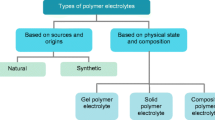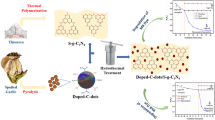Abstract
A composite material based on overlapped layers of electrochemically synthesized Prussian Blue (PB) and terthiophene-derived polymer is described, aiming at enhancing the stability of the hexacyanoferrate thanks to the protective action of the polymer. Two bilayer configurations and deposition methods (for the polymer component) were tested. The morphology and electrochemical behavior in organic solvent and in aqueous solutions containing different supporting electrolytes were carried out. The best performances of electrodes modified with films of the composite material as to increased stability of PB were achieved with the potentiostatically deposited polymer covering the PB layer, in acetate buffer at pH 5.5. As for potential cycling stress, the anodic and cathodic peak currents due to PB were not decreased after 20 cycles. Conversely, PB alone displayed the anodic peak currents relevant to PB/Prussian White (PW) and PB/Berlin Green (BG) systems decreased by about 30 %. The stability to local pH increase was assessed by cyclic voltammetry after electrochemical reduction of H2O2. For example, the anodic peak currents were decreasing by 15 % and 5 % for the two PB redox systems, while for PB alone the same currents decreased by 35 % and 10 %. The response sensitivity to hydrogen peroxide was improved by 54 %, with respect to PB alone, as evaluated by chronoamperometry.








Similar content being viewed by others
References
de Tacconi NR, Rajeshwar K, Lezna RO (2003) Metal hexacyanoferrates: electrosynthesis, in situ characterization, and applications. Chem Mater 15:3046–3062
Ricci F, Palleschi G (2005) Sensor and biosensor preparation, optimisation and applications of Prussian Blue modified electrodes. Biosens Bioelectron 21:389–407
Karyakin AA (2001) Prussian Blue and its analogues: electrochemistry and analytical applications. Electroanalysis 13:813–819
Roig A, Navarro J, Garcia JJ, Vicente F (1994) Voltammetric study of the stability of deposited Prussian blue films against successive potential cycling. Electrochim Acta 39:437–442
Karyakin AA, Karyakina EE, Gorton L (1999) On the mechanism of H2O2 reduction at Prussian Blue modified electrodes. Electrochem Commun 1:78–82
Toyoda Y, Katoh N, Kuwabara K (2004) Dependence of redox characteristics in Prussian blue-modified electrode on pH of electrolytic solution. Mater Sci Eng B 108:271–277
Jones CW (1999) Applications of hydrogen peroxide and derivatives. Royal Society of Chemistry, Cambridge
Schwake A, Ross B, Cammann K (1998) Chronoamperometric determination of hydrogen peroxide in swimming pool water using an ultramicroelectrode array. Sens Actuators B 46:242–248
Corveleyn S, Vandenbossche GMR, Remon JP (1997) Near-infrared (NIR) monitoring of H2O2 vapor concentration during vapor hydrogen peroxide (VHP) sterilisation. Pharm Res 14:294–298
Hsu C-L, Jang H-D, Su M-S, Chang K-S, Huang Y-S (2008) Amperometric determination of hydrogen peroxide residue in beverages using a Nafion modified palladium electrode. Eur Food Res Technol 226:809–815
Wang Y, Huang J, Zhang C, Wei J, Zhou X (1998) Determination of hydrogen peroxide in rainwater by using a polyaniline film and platinum particles co-modified carbon fiber microelectrode. Electroanalysis 10:776–778
Campanella L, Roversi R, Sammartino MP, Tomassetti M (1998) Hydrogen peroxide determination in pharmaceutical formulations and cosmetics using a new catalase biosensor. J Pharm Biomed Anal 18:105–116
Wang J (2008) Electrochemical glucose biosensors. Chem Rev 108:814–825
http://www.cefic.org/Documents/Other/CEFIC-H2O2-7157.pdf. Accessed 10 Mar 2010
Chang Q, Zhu L, Jiang G, Tang H (2009) Sensitive fluorescent probes for determination of hydrogen peroxide and glucose based on enzyme-immobilized magnetite/silica nanoparticles. Anal Bioanal Chem 395:2377–2385
Marle L, Greenway GM (2005) Determination of hydrogen peroxide in rainwater in a miniaturised analytical system. Anal Chim Acta 548:20–25
Voraberger H, Ribitsch V, Janotta M, Mizaikoff B (2003) Application of mid-infrared spectroscopy: measuring hydrogen peroxide concentrations in bleaching baths. Appl Spectrosc 57:574–579
Pinkernell U, Effkemann S, Karst U (1997) Simultaneous HPLC determination of peroxyacetic acid and hydrogen peroxide. Anal Chem 69:3623–3627
Stephenson NA, Bell AT (2005) Quantitative analysis of hydrogen peroxide by 1H NMR spectroscopy. Anal Bioanal Chem 381:1289–1293
Scandurra G, Arena A, Ciofi C, Saitta G (2013) Electrical characterization and hydrogen peroxide sensing properties of gold/Nafion:Polypyrrole/MWCNTs electrochemical devices. Sensors 13:3878–3888
Onoda M, Uchiyama T, Mawatari K, Kaneko K, Nakagomi K (2006) Simple and rapid determination of hydrogen peroxide using phosphine-based fluorescent reagents with sodium tungstate dihydrate. Anal Sci 22:815–817
Mignani A, Scavetta E, Tonelli D (2006) Electrodeposited glucose oxidase/anionic clay for glucose biosensors design. Anal Chim Acta 577:98–106
Karyakin AA, Karyakina EE (1999) Prussian Blue-based ‘artificial peroxidase’ as a transducer for hydrogen peroxide detection. Application to biosensors. Sens Actuators B 57:268–273
Guadagnini L, Maljusch A, Chen X, Neugebauer S, Tonelli D, Schuhmann W (2009) Visualization of electrocatalytic activity of microstructured metal hexacyanoferrates by means of redox competition mode of scanning electrochemical microscopy (RC-SECM). Electrochim Acta 54:3753–3758
de Mattos IL, Gorton L, Ruzgas T, Karyakin AA (2000) Sensor for hydrogen peroxide based on Prussian Blue modified electrode: improvement of the operational stability. Anal Sci 16:795–798
Senthil Kumar SM, Chandrasekara Pillai K (2006) Compositional changes in unusually stabilized Prussian blue by CTAB surfactant: application to electrocatalytic reduction of H2O2. Electrochem Commun 8:621–626
Nossol E, Zarbin JG (2013) Electrochromic properties of carbon nanotubes/Prussian blue nanocomposite films. Sol Energy Mater Sol C 109:40–46
Mortimer RJ (1995) Electrochemical responses of bilayer electrodes with Prussian blue as the ‘inner’ layer and electroactive cation-incorporated Nafion® as the ‘outer’ layer. J Electroanal Chem 397:79–86
Thakur B, Savant SN (2013) Polyaniline/Prussian-Blue-based amperometric biosensor for detection of uric acid. Chem Plus Chem 78:166–174
Koncki R, Wolfbeis OS (1998) Composite films of Prussian Blue and N-substituted polypyrroles: fabrication and application to optical determination of pH. Anal Chem 70:2544–2550
Lupu S, Mihailciuc C, Pigani L, Seeber R, Totir N, Zanardi C (2002) Electrochemical preparation and characterisation of bilayer films composed by Prussian Blue and conducting polymer. Electrochem Commun 4:753–758
Noël V, Randriamahazaka H, Chevrot C (2000) Composite films of iron(III) hexacyanoferrate and poly(3,4-ethylenedioxythiophene): electrosynthesis and properties. J Electroanal Chem 489:46–54
Lisowska-Oleksiak A, Nowak AP (2007) Metal hexacyanoferrate network synthesized inside polymer matrix for electrochemical capacitors. J Power Sources 173:829–836
Lisowska-Oleksiak A, Nowak AP (2008) Impedance spectroscopy studies on hybrid materials consisting of poly(3,4-ethylenedioxythiophene) and iron, cobalt and nickel hexacyanoferrate. Solid State Ionics 179:72–78
Chiu J-Y, Yu C-M, Yen M-J, Chen L-C (2009) Glucose sensing electrodes based on a poly(3,4-ethylenedioxythiophene)/Prussian blue bilayer and multi-walled carbon nanotubes. Biosens Bioelectron 24:2015–2020
Lupu S, Lakard B, Hihn J-Y, Dejeu J, Rougeot P, Lallemand S (2011) Morphological characterization and analytical application of poly(3,4-ethylenedioxythiophene)–Prussian blue composite films electrodeposited in situ on platinum electrode chips. Thin Solid Films 519:7754–7762
Zhang Q, Zhang L, Li J (2008) Fabrication and electrochemical study of monodisperse and size controlled Prussian blue nanoparticles protected by biocompatible polymer. Electrochim Acta 53:3050–3055
Lupu S, del Campo FJ, Muñoz FX (2010) Development of microelectrode arrays modified with inorganic–organic composite materials for dopamine electroanalysis. J Electroanal Chem 639:147–153
Limachi DGB, Gonçales VR, Cintra EP, Córdoba de Torresi SI (2013) Controlling hydrophilicity and electrocatalytic properties of metallic hexacyanoferrates/conducting polymers hybrids for the detection of H2O2. Electrochim Acta 110:459–464
Zanardi C, Terzi F, Seeber R (2013) Polythiophenes and polythiophene-based composites in amperometric sensing. Anal Bioanal Chem 405:509–531
Dini D, Decker F, Andreani F, Salatelli E, Hapiot P (2000) A comparative study of isomeric polydialkyl terthiophenes with regular regiochemistry of substitution. Electrochemical synthesis. Polymer 41:6473–6480
Pigani L, Seeber R, Terzi F, Zanardi C (2004) Influence of the nature of the supporting electrolyte on the formation of poly[4,4′-bis(butylsulphanyl)-2,2′-bithiophene] films. A role for both counter-ion and co-ion in the polymer growth and p-doping processes. J Electroanal Chem 562:231–239
Mortimer RJ, Rosseinsky DR (1983) Electrochemical polychromicity in iron hexacyanoferrate films, and a new film form of ferric ferricyanide. J Electroanal Chem 151:133–147
Kellawi H, Rosseinsky DR (1982) Electrochemical bichromic behaviour of ferric ferrocyanide (Prussian Blue) in thin film redox processes. J Electroanal Chem 131:373–376
Dass A, Mulik S, Sotiriou-Leventis C, Leventis N (2006) Protection of 2-(3-thienyl)ethanol with 3-thienylacetic acid and hard cross-linked conducting films by polymerization of the ester. Synth Met 156:966–972
Mouffouk F, Brown SJ, Demetriou AM, Higgins SJ, Nichols RJ, Gamini Rajapakse RM, Reeman S (2005) Electrosynthesis and characterization of biotin-functionalized poly(terthiophene) copolymers, and their response to avidin. J Mater Chem 15:1186–1196
Audebert P, Catel JM, Le Coustumer G, Duchenet V, Hapiot P (1998) Electrochemistry and polymerization mechanisms of thiophene−pyrrole−thiophene oligomers and terthiophenes. Experimental and theoretical modeling studies. J Phys Chem B 102:8661–8669
Dini D, Decker F, Zotti G, Schiavon G, Zecchin S, Andreani F, Salatelli E (1999) Comparative study of isomeric polyalkylthiophenes with regular regiochemistry of substitution: characterization of electrochemical doping process. Chem Mater 11:3484–3489
Hofmeister F (1888) Zur Lehre von der Wirkung der Salze. Zweite Mittheilung. Arch Exp Pathol Pharmakol 24:247–260
Randriamahazaka H, Noël V, Chevrot C (1999) Nucleation and growth of poly(3,4-ethylenedioxythiophene) in acetonitrile on platinum under potentiostatic conditions. J Electroanal Chem 472:103–111
Leventis N, Chung YC (1992) Poly(3-methylthiophene)–Prussian Blue: a new composite electrochromic material. J Mater Chem 2:289–293
Itaya K, Uchida I (1986) Electrochemistry of polynuclear transition metal cyanides: Prussian Blue and its analogues. Acc Chem Res 19:162–168
Doménech A, Montoya N, Scholz F (2011) Estimation of individual Gibbs energies of cation transfer employing the insertion electrochemistry of solid Prussian blue. J Electroanal Chem 657:117–122
Acknowledgments
The authors are grateful to the University of Bologna for providing financial support.
Author information
Authors and Affiliations
Corresponding author
Rights and permissions
About this article
Cite this article
Guadagnini, L., Salatelli, E., Kharina, A. et al. Electrochemically deposited thiophene-based polymers as protective agents for Prussian Blue thin films. J Solid State Electrochem 18, 2731–2742 (2014). https://doi.org/10.1007/s10008-014-2530-z
Received:
Revised:
Accepted:
Published:
Issue Date:
DOI: https://doi.org/10.1007/s10008-014-2530-z




